The fourth session of the Bridging the Divide series focused on the women’s suffrage movement and misconceptions around the movement. The session was moderated by Kenya Young ’94, Executive Producer of Morning Edition at National Public Radio (NPR) and included speakers Dianne Pinderhughes, Notre Dame Presidential Faculty Fellow, and Professor in the Department of Africana Studies and the Department of Political Science and Christina Wolbrecht, Professor of Political Science, Director of the Rooney Center for the Study of American Democracy, and C. Robert and Margaret Hanley Family Director of the Notre Dame Washington Program. The discussion aimed to explore the diverse identities of women, and how this diversity is reflected in their voting patterns.
The first topic of discussion focused on expectations regarding women’s vote in the 2020 election and assumptions of suburban women. Wolbrecht explained how, in reality, there is not a “women’s vote” as women are diverse in their interests and identities, and that is reflected in their voting behavior. Both Wolbrecht and Pinderhughes emphasized how the idea of suburban women does not represent the majority of women, and it is important to think about who women really are as the female population in America has very diverse identities and perspectives. Furthermore, Pinderhughes highlighted the issue of narrowing the scope in terms of what people think is important to women. She explained how women care about many more political issues than generally expected of them such as education, employment issues, public transportation, the economy, and many more. Wolbrecht built on this idea by sharing how women are more likely to be care workers and have less wealth in today’s society, so their evaluation of the economy or what they want to see the government do is slightly different than men’s. That is generally where gender differences are seen.
Another key topic discussed regarded the gender gap and why women tend to vote more Democratically than men. It was shared that the gender gap originated in the 1980s when parties initially polarized on women’s rights issues; Republicans took a pro-life position and removed the equal rights amendment from their platform, while Democrats supported the equal rights movement and took a strong pro-choice position. Although it is a general tendency for women to vote blue, the speakers reminded us that gender gaps change between demographics, and it is important to realize how groups of women in various communities differ.
The discussion ended with an important conversation around voting rights for women and in general. Pinderhughes highlighted how access to voting is an issue for black voters and people of color, but if the barriers are complex enough it can affect the entire population. She also explained how there are still high tensions between women of color, and these women need to talk with each other about these issues and challenges still being faced. The powerful discussion finished up with an emphasis on the need for respectful and open-minded discussions about important topics, such as the 19th Amendment and myths around the women’s vote in America.
Visit the event page for more.










